Specialists in pest control
We are able to offer the services you need to get pests and insects out of your home or business premises. We have the experience and skills to serve you effectively, and you’re assured of a great service with Clear Round Pest Services. Get in touch with us now.

WASPS
Wasps live in nests that are typically found in roof spaces, airbricks, cavity walls, garden sheds, trees and even in rockeries, flowerbeds and shrubs.
The nest is usually constructed from chewed bark and dried timber mixed with saliva, and is a light grey/beige colour with a papery appearance. If undisturbed and built in an unrestricted space, the nest can measure between 90-120cm in circumference towards the end of the summer months. A nest this size contains anywhere between 5,000-10,000 individual wasps.
New nests are formed each year by queen wasps that have over-wintered. Depending on the weather, nests can be found in late spring/early summer. The worker wasps die in the autumn and the nest is never reused.
Queen wasps which have over-wintered are sometimes seen in later winter during warm weather. There may be several together and they are larger than normal wasps. It is unlikely that they will build a nest at this time of the year.

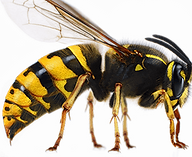
Wasps are aggressive when disturbed and will sting. It is painful and can cause redness and/or swelling but a sting is not normally serious, unless you are stung around the face, mouth, throat or tongue or suffer an allergic reaction (this is known as anaphylactic shock). In these cases, you should get immediate medical attention, as severe anaphylactic shock can be fatal. If a nest is causing a nuisance then it is best treated professionally.
Wasps never reuse an old nest, so if you are certain that there is no activity, it can simply be removed and disposed of. Any nest found during the winter will be dead and can be safely removed.
Clear Round Pest Services have effective treatments for wasp nests in all situations. Treated nests are dead within 24 hours and in most cases only a few hours.


ANTS
Garden/black ants are not regarded as a significant risk to public health, however they can be a nuisance when found in the home. Garden ants are found throughout Britain and usually nest in gardens and areas around buildings. They often enter homes in search of food.
Garden ants can find the smallest of cracks and if they locate a source of food within a building, they communicate this to other ants and then lead them into the building to feed. During the summer - the flying stage for ants - they may be seen emerging from the nest in large numbers. This event normally lasts for only a few days.
Food sources, i.e. sugary foods, should be kept in sealed containers and all food and drink spillages cleared up immediately. Should ants become a nuisance, Clear Round Pest Services have effective treatments for all situations. Treated nests are normally dead after a few hours and definitely so within 24.
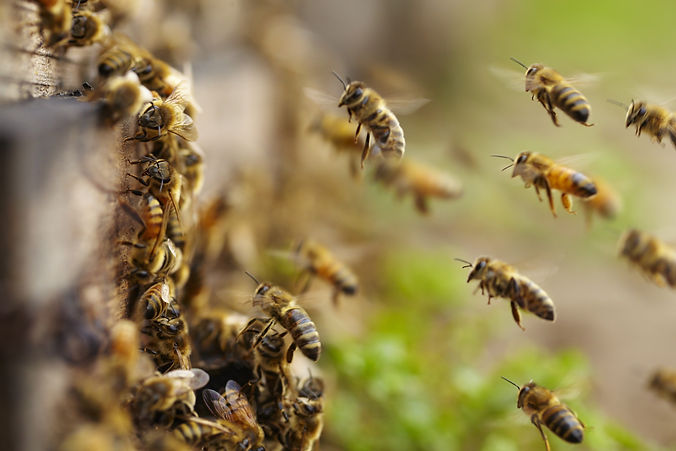
BEES
There are many types of bee, including honey bees, bumble bees, masonry bees and minor or burrowing bees, all of which are common in Britain. Most are harmless and - once their behaviour is understood - pose no threat to people.
Bumble bees come in various different varieties, all of which produce a nest in the spring from one over-wintered queen bee. These nests grow in size over the summer and finally produce young queens which in time will over-winter to start their own nests the following spring. They rarely cause problems and it is only if their entrance becomes blocked that a number of them will be seen.
They are relatively harmless and should be left where possible to complete their life cycle. The nests are annual and only last for one summer. They will not reoccur the following year and they do not swarm.
Honey bees are classed as a domestic insect and occasionally go wild (feral). This normally occurs in the early summer months when colonies become overcrowded and they swarm. When swarming occurs, one queen will leave a colony taking with her many thousands of worker bees. These will then gather in a mass whilst scout bees go off to find them a new permanent home.
Should honey bees enter a property there may be the necessary to treatment, but only after ever chance to let them to leave has been exhausted.
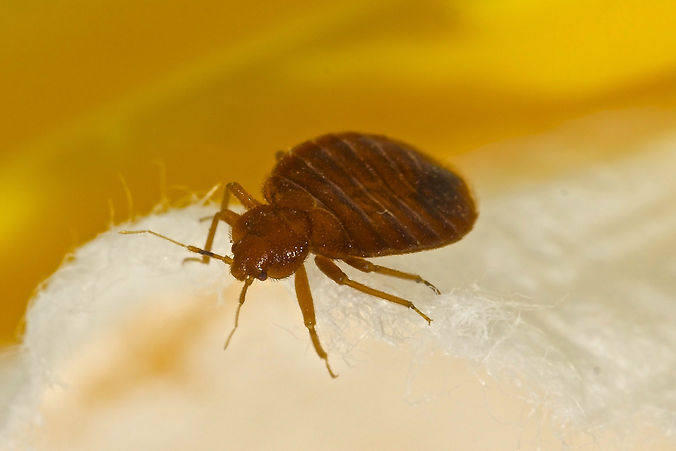
BEDBUGS
Bedbugs are wingless, oval shaped, flattened insects, usually about 6mm long. When they have not eaten they are pale brown in colour but become reddish brown to mahogany when fully fed on blood. The head has large antennae and the mouthparts are well adapted for piercing the skin. Young bugs (nymphs) are nearly colourless, becoming increasingly brown as they mature and reach adulthood. Bedbugs can crawl up vertical wood, paper and plaster surfaces, but are unable to crawl up smooth polished surfaces.
They're found wherever human beings sleep within a property. They can be carried into the home on luggage brought in after a stay at an infested hotel or dwelling. Bedbugs can also enter the home on second-hand furniture and in very rare cases can be brought in on a person’s clothes.
They are nocturnal and spend most of their time hiding in various areas of an infested room (i.e. floor cracks, under carpets and behind loose wallpaper, pictures, skirting boards and door frames etc). They commonly appear in the seams, piping and buttons of bed mattresses and on bedroom furniture.
Modern buildings often allow bedbugs to migrate along terraced houses and between flats, spreading the problem away from the original infestation.
Bedbugs feed exclusively on blood, normally every 3-4 days and generally only in darkness. Although human blood is preferred, they can survive on blood from rabbits, dogs, cats and rodents etc.
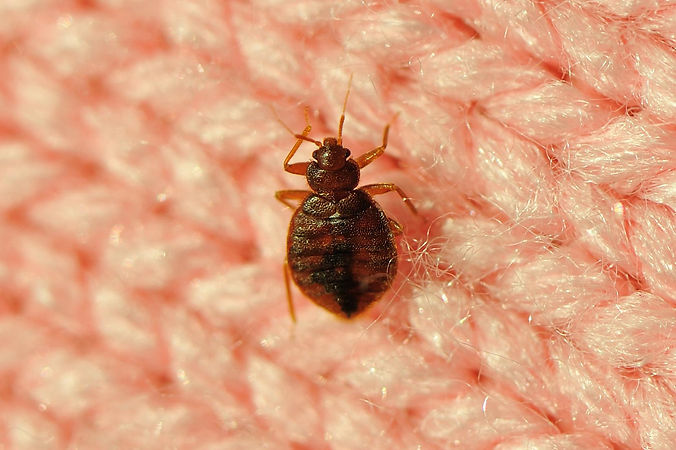
Bedbugs can survive extreme starvation and have been known to survive up to 12 months without feeding.
Apart from live sightings, evidence of faecal marks near cracks and crevices and on bed linen and bed frames can be signs of an infestation. If there are bedbugs in sufficient numbers, an unpleasant almond-like smell may be detected in infested rooms.
They can cause a substantial nuisance to humans due to their diet. Bites often result in a hard white swelling, unlike flea bites which leave a dark red spot. Itching caused by bites and secondary infection due to scratching is very common. Bedbugs are not known to be carriers of human disease though.
Treatment must be thorough to ensure complete control. The standard treatment for infested premises is the application of an insecticide approved for use against bedbugs. The insecticide is applied to all cracks and crevices where bedbugs could be hiding, such as within bed frames, flooring, skirting boards etc. Mattresses are lightly sprayed with water-diluted spray. All bed linen should be washed at the hottest temperature that the material will allow. It is recommended to avoid vacuuming for 14 days after the treatment. After the treatment has been carried out, it is important to monitor for several weeks to ensure that the treatment has been successful.

CARPET MOTHS
Carpet moths have a very similar life cycle to carpet beetles. It is the larvae that does the damage to carpets as they eat any natural fibres within the pile. Apart from bare patches in the carpet, other signs are small white paper-like cases around 6-7mm long. These are most often found under pieces of furniture which have not been moved for some time. They are silk cocoons which the lava spins and from which the adult moths emerge. The eggs of the moth are sticky and it is by this method that they are transferred from room to room.
The treatment for a carpet moth infestation is the same as for carpet beetle infestation, namely a residual insecticide and a fogging treatment.

CLUSTER FLIES
Although they do not pose a health risk, cluster flies can still cause discomfort and inconvenience during the autumn and winter months when they come into houses to hibernate.
Principal activity is in the autumn - when the flies come into a property - and in the spring - when they come out of hibernation. They can be a nuisance during the winter months when property heating systems wake them up prematurely and they enter the living space through loft hatches and light fittings. They can also be found between windows and window frames. It is recommended to carry out treatments after the first frosts of winter, at which point the majority of these insects will have set up shop. The treatment is relatively simple and very effective for these seasonal pests.
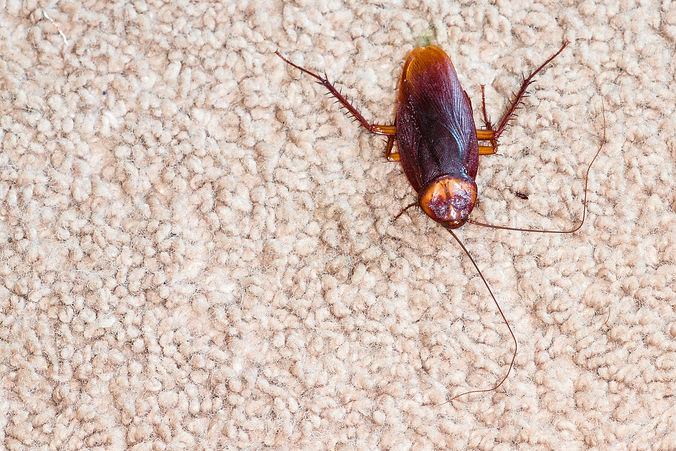
COCKROACHES
Cockroaches are generally found indoors, in areas such as cellars, basements, kitchens, bakeries and heating ducts, although the Oriental cockroach can survive outdoors in Britain. Cockroaches will often remain hidden during the day, using cracks and crevices as harbourages. Most species can climb with ease, especially the German cockroach which can climb smooth vertical surfaces.
Cockroaches can survive for several months without food, but will not live for more than a few days without water.
The two main species of cockroach in Britain are the Oriental cockroach - which is dark brown in colour and about 30mm long - and the German cockroach - which is light, yellowish brown and about 12mm long. Both species' bodies are divided into three sections and they feature long antennae that protrude from the head. Immature cockroaches look just like the adults but on a smaller scale. There may be a distinctive odour that will signify an infestation.
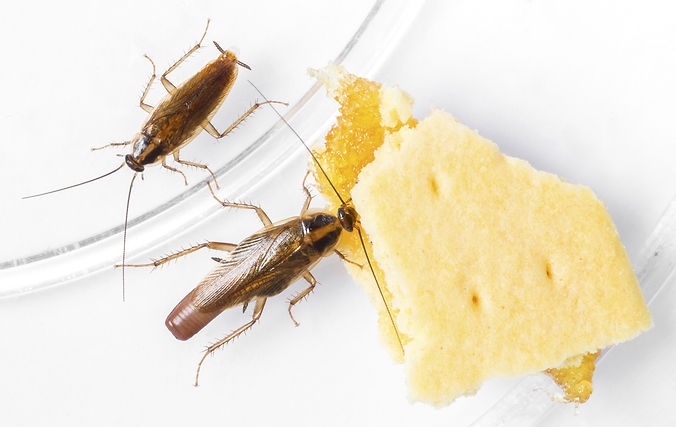
Cockroaches can carry bacteria, especially organisms which often cause food poisoning in humans. They will feed on almost anything, including refuse, faecal matter and food for human consumption.
A thorough cleansing of the area should take place prior to the insecticidal treatment, with close attention paid to food and water sources as well as hiding places. Sticky traps can be used to monitor the extent of the infestation.
Many of the insects and their egg cases are hidden in cracks and crevices, so particular attention is paid to these areas when applying insecticides. To control an infestation, the egg cases should also be tackled, meaning repeated treatments.
Baits can also be used, providing continuous cockroach control over an extended period. The cockroaches will feed on these baits, picking up enough insecticide to kill them.
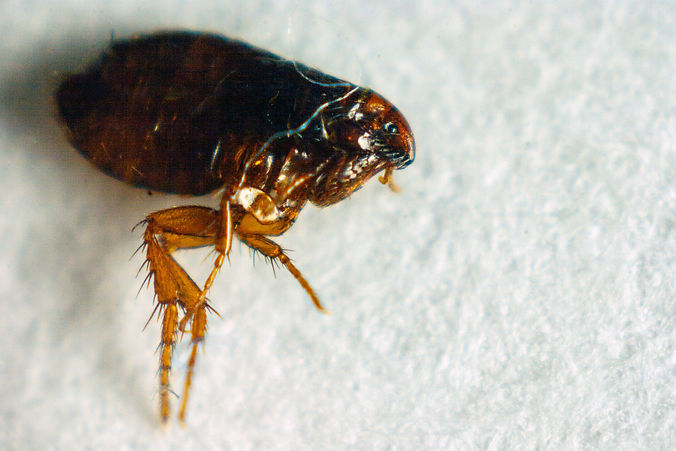
FLEAS
Adult fleas are normally 1-4mm long, brownish in colour, without wings, but with powerful legs adapted for jumping. Female fleas can live up to two years, during which they can lay up to 1000 eggs.
Adult fleas live exclusively as parasites of warm-blooded animals. The females lay their eggs - on the floor or in an animal's bedding - after feeding on the infested animal. After several days, the eggs will develop into larvae. After two to three weeks, the larvae will be fully developed. The larvae will then spin a cocoon, where it will reside for a further two to three weeks before emerging as an adult flea. Larvae feed on debris and adult flea droppings. Adult fleas feed solely on the host's blood.
Your pet's constant scratching will be the first sign of an infestation. You may then find either fleas or flea droppings in the coat. Flea droppings are small black specks, mainly composed of dried blood, and they are usually seen in clusters lying next to the skin. They are easy to spot in light-coloured animals through brushing back the hair. In dark-coated breeds, it may be better to comb the animal over a sheet of paper onto which any flea droppings will then fall. The nature of the black specks can be confirmed by adding a few drops of water – if they turn red, your pet has fleas.

FLEA TREATMENTS
We specialise in chemical treatments at Clear Round Pest Services. Chemical treatments can have two elements. First is an adulticide, which effects junior and adult fleas causing them to die. The second is a growth regulator which effects the eggs and larvae, so that they hatch malformed and can not survive.
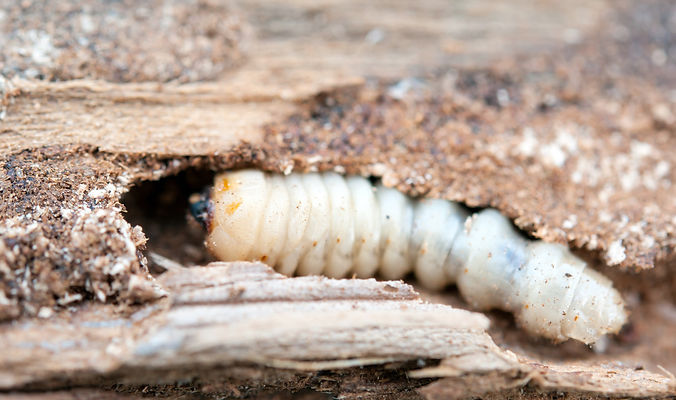
WOODWORM
The adult beetle emerges from the timber between April and June. After mating, the female lays clusters of eggs within timber joints and cracks. When the larvae hatch, they bore into the timber and remain within for up to 5 years, consuming the timber all the while. When they are finally ready to pupate, they tunnel to just below the surface of the timber where they then turn into the adult beetle and finally emerge after having chewed away the final section of timber.
Clear Round Pest Services can offer woodworm treatment with a 10 year guarantee and back up bonded guarantee if required. Clear Round Pest Services is an approved contractor with Permagard Ltd.

GOT AN INSECT INFESTATION?
If you’re in need of an insect control specialist, choose our experts for a professional service.


